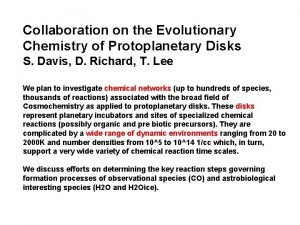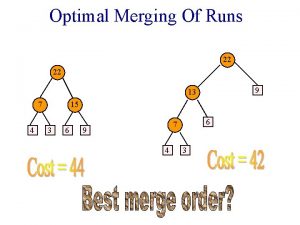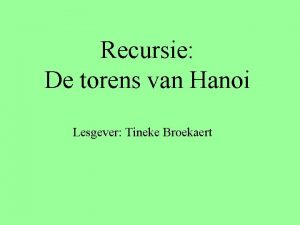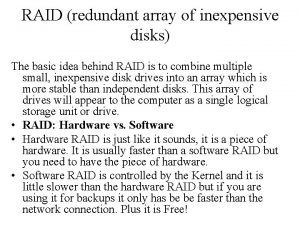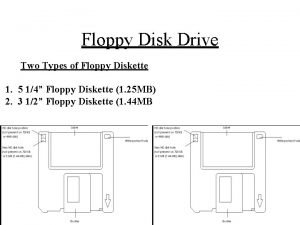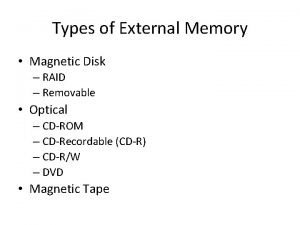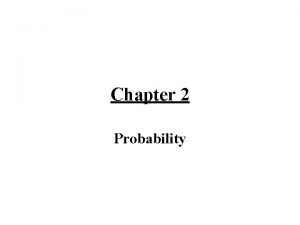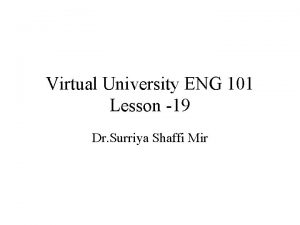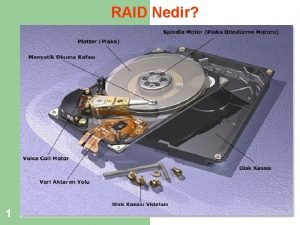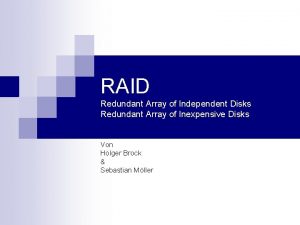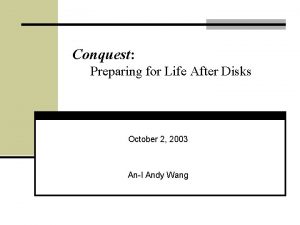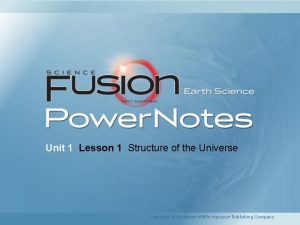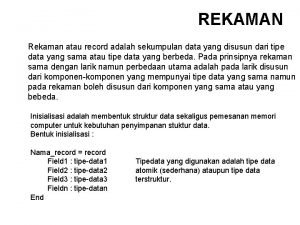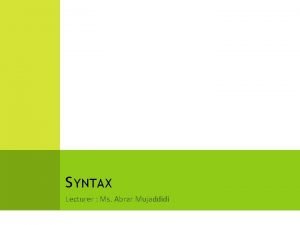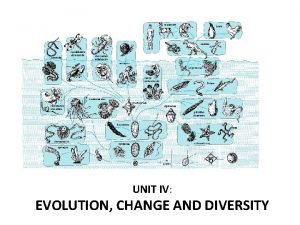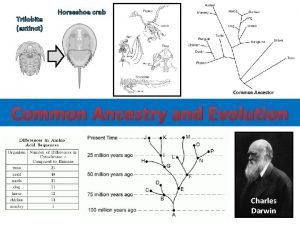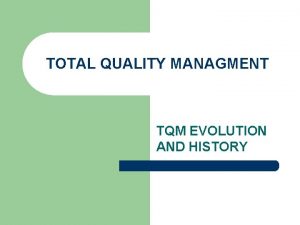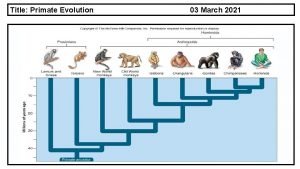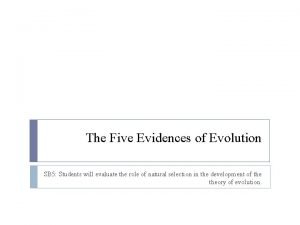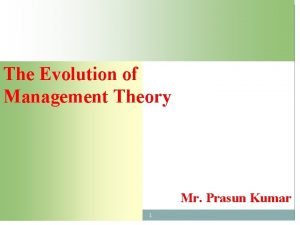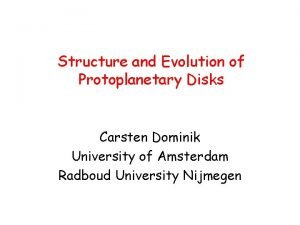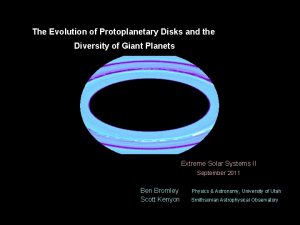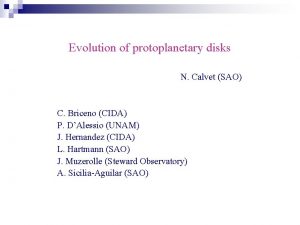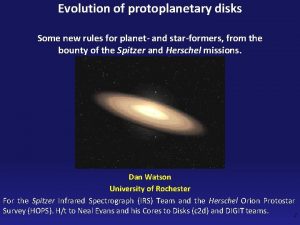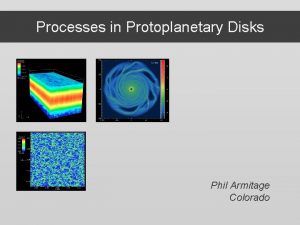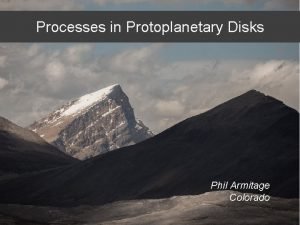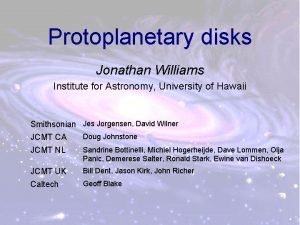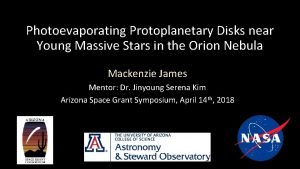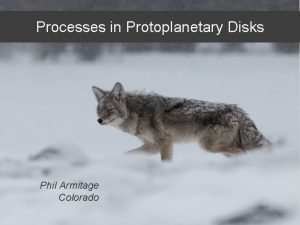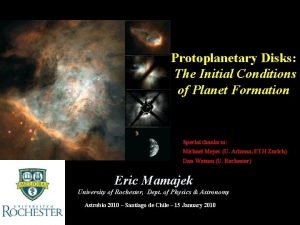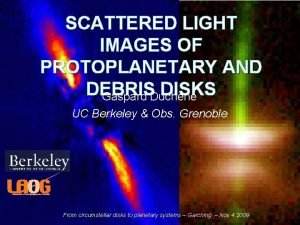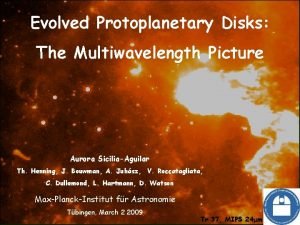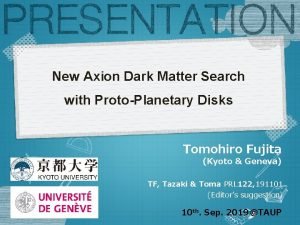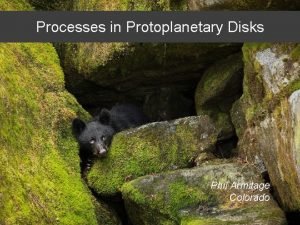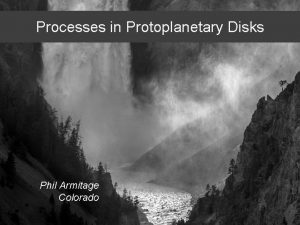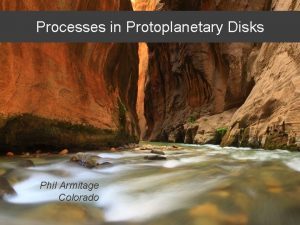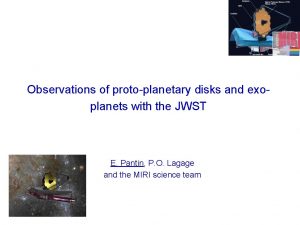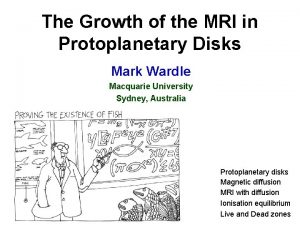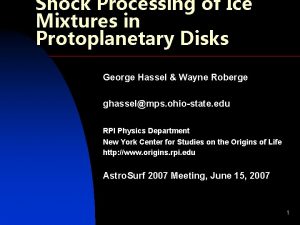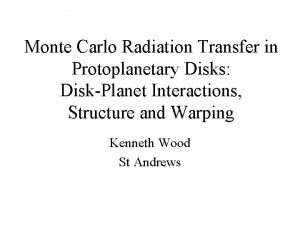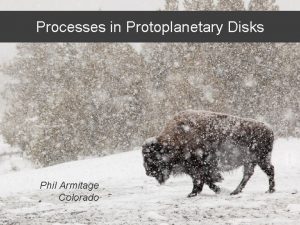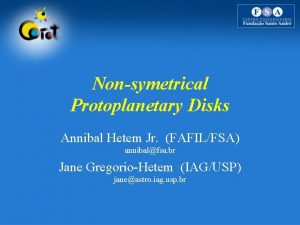Structure Evolution of Protoplanetary Disks Merging 3 D











































- Slides: 43

Structure & Evolution of Protoplanetary Disks: Merging 3 D Radiation Transfer & Hydrodynamics Kenneth Wood St Andrews

Data Radiation Transfer Models & Observational Signatures Theory Data: Imaging polarimetry Photometric monitoring Scattered light images Spectral energy distributions (SEDs) Theory: Dynamical models of star formation: Collapsing clouds, jets, accretion disks, debris disks, & planet formation RT Models: 3 D Monte Carlo techniques

Friends & Collaborators RT Models & Dust Theory: Barbara Whitney, Jon Bjorkman, Mike Wolff Dynamical Models: Ken Rice, Ian Bonnell, Phil Armitage, Matthew Bate, Scott Kenyon, Adam Frank Observations: Charlie Lada, Ed Churchwell, Anneila Sargent, Glenn Schneider, Angela Cotera, Debbie Padgett, Keivan Stassun

Monte Carlo Capabilities • • • 3 D geometry & illumination Incorporate MHD density & velocity grids Scattered light images (optical & infrared) Radiative equilibrium dust temperatures SEDs & thermal imaging (mid-IR, sub-mm)

Star Formation Theory Class 0 Class II

Star Formation: Observations l. Fl “ 0” 1 10 “I” 1000 BHR 71 1 10 1000 “II” l(mm) IRAS 04302+2247 Padgett et al. 1999 Bourke 2001 1 10 1000 TW Hydrae Krist et al. 2000

Near-IR HST Images

Disks, Disks…

T Tauri Accretion Disks: Images Disk density: hydrostatic flared disk: h / r = cs(r) / W(r) Shakara & Sunyaev (1973), Lynden-Bell & Pringle (1974) Direct starlight 10, 000 brighter than scattered light from disk Best detected when star occulted by edge-on flaring disk 400 AU • • i = 25 i = 75 i = 85 Whitney & Hartmann 1992

T Tauri Accretion Disks: SEDs • Pole-on: • Edge-on: Large IR excess Double peaked SED: scattered light + thermal Wood et al. 2002

Star Formation in Taurus © Steve Kohle & Till Credner, Allthe. Sky. com

L 1551 Region L 1551 IRS 5 HL Tau XZ Tau HH 30 IRS Red = [S II] White = Visual 1’ = 8400 AU Whitney, Gomez, & Kenyon (Mt Hopkins, 48”)

HH 30 IRS Accretion Disk HST WFPC 2: Green: F 555 W (V Band) Red: F 617 N (Ha, S[II]) Bacciotti et al. 1999 Scattered light models: Assume ISM dust opacity Image morphology: disk geometry, inclination Width of dust lane: optical depth, disk mass Burrows et al. 1996

HH 30 IRS: Disk Geometry HST WFPC 2 Model Hydrostatic flared disk, i = 84 Dust + gas suspended above midplane Consistent with T(r), S(r) for irradiated disks (D’Alessio et al. 1999)

Multiwavelength Models V (0. 55 mm) ISM Dust: I (0. 85 mm) K (2. 25 mm) Opacity decreases by 10 from V to K Dust lane width decreases into IR Very compact nebulosity at K Wood et al. 1998

V (0. 55 mm) I (0. 85 mm) K (2. 25 mm) NICMOS: Wide dust lane at K Circumstellar dust is GRAYER than ISM dust Grain Growth in disk Cotera et al. 2001

HH 30 IRS: SED Models Model: Geometry from HST images; Heating: starlight + accretion Model HST images and SED: Determine dust size distribution Find: Grayer opacity Optical opacity < ISM Larger disk mass (t ~ k. M) Md ~ 2 * 10 -3 M 8 Wood et al. 2002

HH 30 IRS: Grain Growth ISM HH 30 IRS Dust Size Distribution: Power law + exponential decay Grain Sizes in excess of 50 mm Grayer opacity, Sub-mm slope ~ 1/l Beckwith & Sargent (1991): sub-mm continuum SEDs: k ~ 1/l

HH 30 IRS: Image Variability

Magnetic Accretion in HH 30 IRS • • Stellar B-field not aligned with rotation axis Truncates disk, accretion along field lines Hot Spots on star at magnetic poles UV excess, photometric modulation B Ghosh & Lamb 1979 Shu et al. 1994

Magnetic Accretion in HH 30 IRS Wood & Whitney 1998

Magnetic Accretion in HH 30 IRS • T*=3500 K; Ts=10000 K; DA ~ 6% • Asymmetric brightening; DV ~ 1. 5 m • Photometric centroid shift: d ~ 0. 5’’ Wood & Whitney 1998 Stapelfeldt et al. 1999

HH 30 IRS: Photometry Wood et al. 2000 DV ~ 1. 5 mag, DT ~ days: Typical of CTTs, accretion hot spots Variability all due to scattered light

GM Aur: Disk/Planet Interaction? 1200 AU Schneider et al. 2002 • NICMOS coronagraph • Scattered light modeling: • Mdisk ~ 0. 04 M 8; Rdisk ~ 300 AU; i ~ 50

GM Aur: Disk/Planet Interaction? • No near-IR excess • SED model requires 4 AU gap: planet? • Lin & Papaloizou; Seyer & Clarke; Nelson, etc

GM Aur: Disk/Planet Interaction? Rice et al. 2002 • 3 D SPH calculation from Ken Rice • Planet at 2. 5 AU clears disk out to 4 AU

GM Aur: Disk/Planet Interaction? Rice et al. 2002 • 3 D SPH calculation from Ken Rice • Planet at 2. 5 AU clears disk out to 4 AU

GM Aur: Disk/Planet Interaction? Rice et al. 2002 • 3 D SPH density grid into Monte Carlo code • SIRTF SED can discriminate planet mass • Centroid shifting ~ 0. 1 mas: Keck, SIM?

Disk Evolution Trapezium Cluster IR-EXCESS = DISKS Cluster age ~ 1. 5 Myr Disk Frequency: 80% Lada et al. 2000

Disk Lifetimes CLUSTER SURVEYS: Disk frequency declines with cluster age Disk Lifetime: ~ 6 Myr Haisch et al. 2000

Disk Evolution • Disk structure does not change • Disk mass decreases homologously • Mass = mass of dust contributing to SED • What Md can near-IR surveys detect? • Observables: SEDs, colors • Current evidence for disk mass evolution?

SED Evolution Wood et al. 2002 d = 500 pc; 10 -8 M 8 < Md < 10 -1 M 8 SIRTF 5 s, 500 secs

Color Evolution Wood et al. 2001

Observing Disk Evolution • • JHKL surveys: disk frequency & lifetime JHKL surveys: detect Md > 10 -7 M 8 Far-IR & (sub)mm: disk mass evolution Mid-IR (10 mm & 25 mm): disk mass evolution

Taurus-Auriga Sources * = I + = II ( = III Gap in K-N distribution: transition from disks to no disks Kenyon & Hartmann 1995

Disk Masses in Taurus-Auriga 1 = 10 -1 M 8 2 = 10 -2 M 8 3 = 10 -3 M 8 etc Evolution models: disk clearing rapid for Md < 10 -6 M 8 Wood et al. 2002

Space Infrared Telescope • • • SIRTF: launch in January 2003 Lot’s of data: 6 Legacy programs Infrared spectra for 3 mm < l < 160 mm Study disks: environments and ages Website with grid of models

Feedback in Star Formation • HH 30 IRS, GM Aur: Signatures of magnetic accretion & SPH models • Bigger Goal: Combine RT and hydro simulations • Temperature, radiation pressure & ionization structure

Disk Temperature Structure T 6 AU 20 AU 300 AU r 1/5 • Stellar photons absorbed at ~ 4 h(r) above midplane • Iterate with dynamics • Self-consistent disk structure

Summary & Future Research • • • Disk Structure & Variability: HH 30, GM Aur Model data with analytic density structures Now testing hydro simulations SIRTF: characterize large numbers of disks Goal: merge radiation transfer & hydro

Monte Carlo Photoionization T* = 40000 K Q(H 0) = 4. 26 1049 s-1 n(H) = 100 cm-3 Calculate 3 D ionization structure Study percolation of ionizing photons in fractal ISM

Stromgren Volume in a Dickey-Lockman Disk 2 Kpc f ~ 10 -3 n(H 0) Ionization fraction Q(H 0) = 2 1050 s-1: Escape fraction = 22% Ionization of HVCs, Magellanic Stream, IGM…

3 D Stromgren Volumes n(H 0) (before) Ionization fraction n(H 0) (after) Clumpy density; 2 sources with Q(H 0) = 2 1050 s-1 3 D ionization structure, shadow regions
 Protoplanetary disk
Protoplanetary disk Sheer strake in ship
Sheer strake in ship Optimal merging of runs
Optimal merging of runs The merging area of an entrance ramp is marked by
The merging area of an entrance ramp is marked by Tower of hanoi 4 disks
Tower of hanoi 4 disks A case for redundant arrays of inexpensive disks
A case for redundant arrays of inexpensive disks Parts of
Parts of Floppy disk
Floppy disk Plotter is a storage device
Plotter is a storage device Types of external memory
Types of external memory Redundant arrays of independent disks
Redundant arrays of independent disks Disks of polycarbonate plastic from a supplier are analyzed
Disks of polycarbonate plastic from a supplier are analyzed Aka.ms/sqlcapacity
Aka.ms/sqlcapacity Disks and tapes can be stored ------- a library. eng101
Disks and tapes can be stored ------- a library. eng101 Anti raid nedir
Anti raid nedir Holger brock
Holger brock Conquest data disks
Conquest data disks Structure and evolution of the universe. lesson 1
Structure and evolution of the universe. lesson 1 Physical state of covalent compounds
Physical state of covalent compounds Union myunion structure my structure integer m float n
Union myunion structure my structure integer m float n Giant molecular structure vs simple molecular structure
Giant molecular structure vs simple molecular structure @prof._jane_blendes:https://semawur.com/xujhhf16p
@prof._jane_blendes:https://semawur.com/xujhhf16p Chomsky theory
Chomsky theory Surface structure and deep structure
Surface structure and deep structure Zinc oxide + nitric acid → zinc nitrate + water
Zinc oxide + nitric acid → zinc nitrate + water Queue is a static data structure
Queue is a static data structure Record adalah
Record adalah Deep structure and surface structure
Deep structure and surface structure Evidence of evolution
Evidence of evolution Evidence for evolution doodle notes
Evidence for evolution doodle notes Evolution of operating systems
Evolution of operating systems What is a offspring
What is a offspring Ancestry
Ancestry Tqm evolution
Tqm evolution Total quality management 14 points
Total quality management 14 points Primate evolution tree
Primate evolution tree Evolution title page
Evolution title page Lamarck's theory of evolution
Lamarck's theory of evolution Developmental homologies
Developmental homologies Gerenuk behavioral adaptations
Gerenuk behavioral adaptations Four forces of evolution
Four forces of evolution Genetic drift
Genetic drift 5 evidence of evolution
5 evidence of evolution Evolution of management theory
Evolution of management theory
